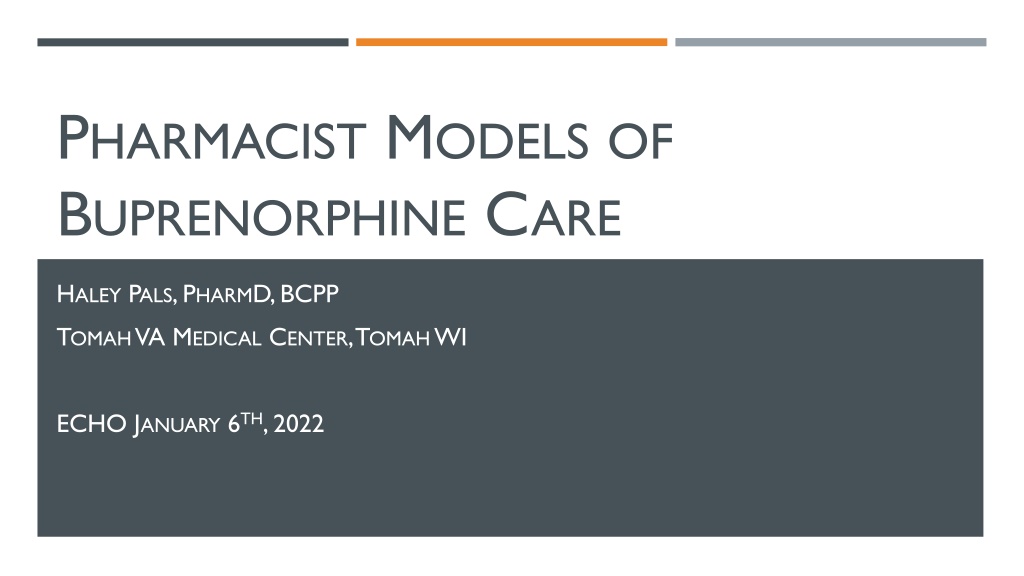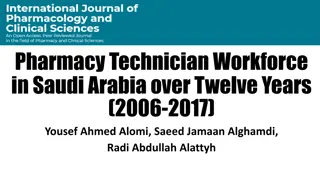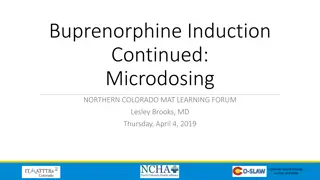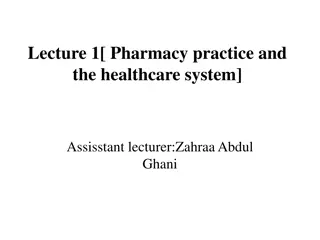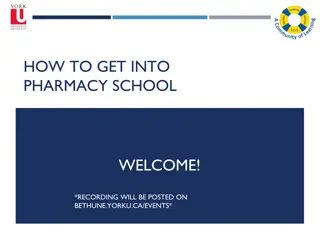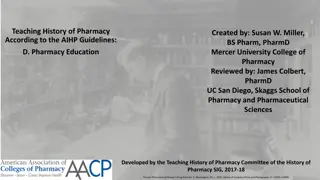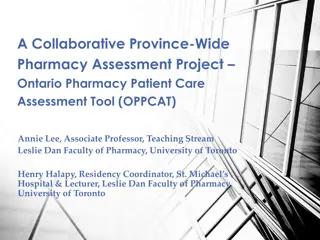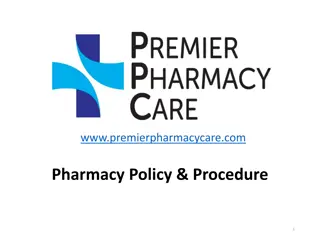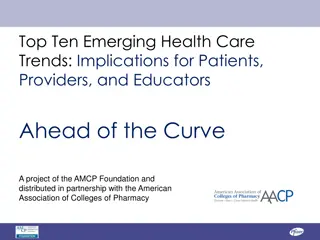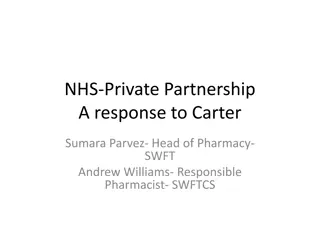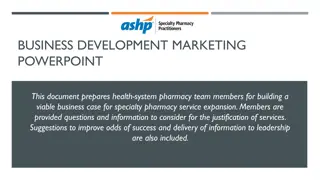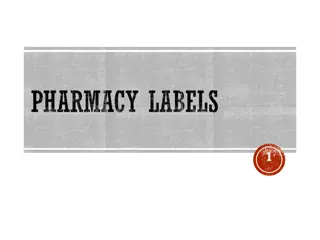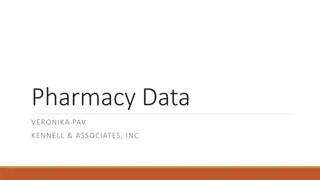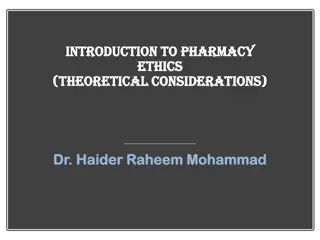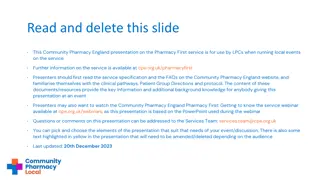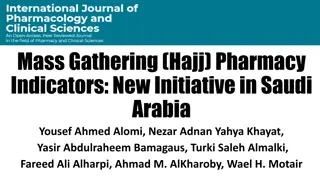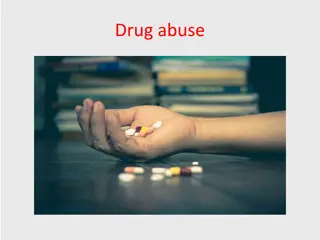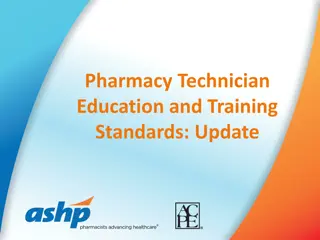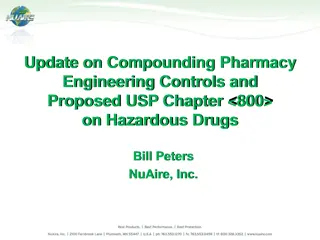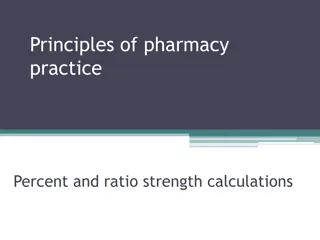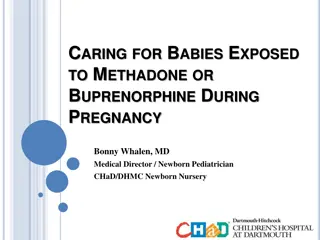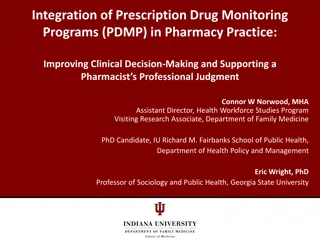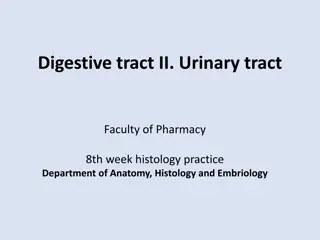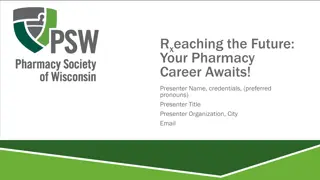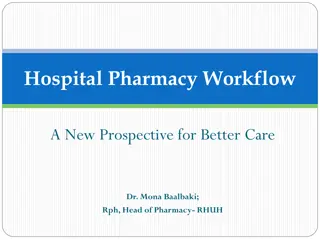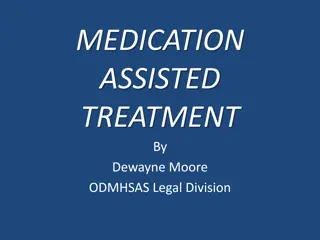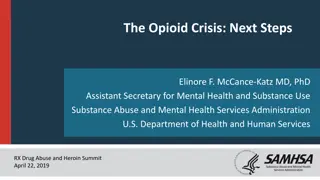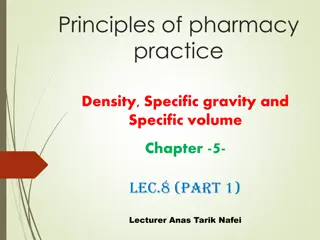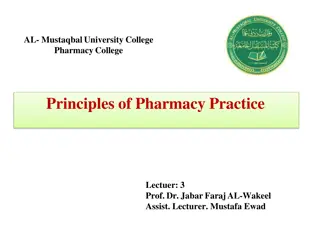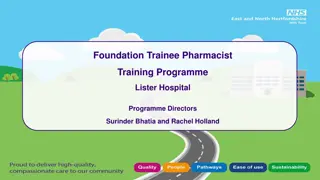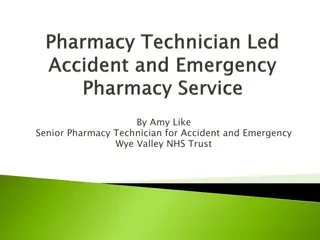Comprehensive Overview of Buprenorphine Care in Pharmacy Practice
This presentation by Haley Pals, PharmD, BCPP, at Tomah VA Medical Center on January 6th, 2022, delves into pharmacist models of buprenorphine care, pharmacist training routes, pharmacy residencies, board certification stats, practice areas, and collaborative care agreements. The content emphasizes pharmacist role expansion, established buprenorphine collaborations, and the significance of pharmacy professionals in collaborative patient care settings.
Download Presentation

Please find below an Image/Link to download the presentation.
The content on the website is provided AS IS for your information and personal use only. It may not be sold, licensed, or shared on other websites without obtaining consent from the author. Download presentation by click this link. If you encounter any issues during the download, it is possible that the publisher has removed the file from their server.
E N D
Presentation Transcript
PHARMACIST MODELS OF BUPRENORPHINE CARE HALEY PALS, PHARMD, BCPP TOMAHVA MEDICAL CENTER, TOMAHWI ECHO JANUARY 6TH, 2022
OBJECTIVES Recognize the possible routes of training for pharmacists Identify various established buprenorphine collaborations Discuss collaborative care agreements
DISCLOSURES No off-label use of medications will be discussed The content of this presentation does not represent the position of the Veterans Health Administration
PHARMACISTTRAINING Physicians: Pharmacists: Undergraduate degree 4 years med school Residency 3-7 years Board certification Undergraduate schooling (2-4 years) 4 years pharmacy school Residency 1-2 years* Board certification* *optional
PHARMACY RESIDENCIES PGY1 For 14,000 graduating pharmacists 4,000 PGY-1 positions available 2021: 7525 applicants Ambulatory Care Hospital Community Managed Care Admin National Matching Services Inc, 2021 Statistics
PHARMACY RESIDENCIES PGY2 For 4,000 PGY-1 residents 1,490 PGY-2 positions available 594 early-committed 1323 applicants Ambulatory Care Critical Care Infectious Disease Oncology Internal Medicine Psychiatric Pediatric National Matching Services Inc, 2021 Statistics
PHARMACY BOARD CERTIFICATION Total Board-Certified Pharmacists = 55,928 (5,000 in 2021) >1,450 Board Certified Psychiatric Pharmacists (BCPP) 0.46% of the pharmacist workforce (yeah, we re a rare breed) Board of Pharmacy Specialties
PHARMACIST PRACTICE AREAS Oster et al, Center for Health Workforce Studies, 2020
HALEYS PRACTICE MODEL
HALEYS TRAINING/CREDENTIALS Pharmacy intern at methadone/buprenorphine clinic PGY-1 Ambulatory Care PGY-2 Psychiatric 24 hours of X-waiver training* DEA licensure BCPP examination Scope of Practice (for VA) *literally all refresher from pharmacy school
SCOPEOF PRACTICE Primary prescriber for the Addiction Treatment Program in MHC Manage panel of patients with SUD/MH diagnoses 40-50 patients/week 26 suboxone patients Order prescriptions (including controls), labs, consults, referrals Bi-annual clinical care review Refer to diagnostic clinicians when necessary
BUPRENORPHINE PROTOCOL oNew initiation: CPP may initiate evaluation and treatment plan with patient; X-waivered provider to evaluate patient in collaboration with CPP to confirm OUD diagnoses/concurrence with plan (i.e. MD must lay eyes on patient , VVC preferred or TMH to clinic for initial assessment. Or make phone/video contact per COVID DEA exceptions) oMaintenance: if CPP enters any new controlled substance for provider signature, provider must add addendum noting concurrence with plan. MD must see patient every 12 months to continue controlled prescription. 1. Steps should be taken to ensure Veteran is seen before this 12-month mark in case of reschedules, no- shows, or other logistic barriers arise 2. Preferred to present to clinic for TMH to receive vitals/nursing assessment every 6 months, or more frequent on case-by-case basis 3. "Furthermore, the provider of record for the controlled substance must document in the medical record the need and intended indication for the controlled substance being prescribed. " Tomah SUD CPP SOP CPP = Clinical Pharmacist Practitioner
BUPRENORPHINE PROTOCOL oCPP uses encounter (CPT) codes for Medication Therapy Management (MTM) o99605 first 15 minutes, NEW patient o99606 first 15 minutes, existing patient o99607 each additional 15 minutes oTo document credit for workload of collaborating with CPP, a provider may complete their own separate encounter with a distinct note identifying the work involved in the chart review and why it is being done. oCPT code 90885 (psychiatric review of records) provides 0.97 wRVU Tomah SUD CPP SOP
BUPRENORPHINE PROTOCOL CPP X-waiver Initial assessment/inductions Conduct routine appointments Complete management of all other MH conditions Order/interpret UDS Order routine labs Prescribe medications Place buprenorphine order for signature Distribute naloxone MH LPN Diagnosis Prescribe buprenorphine Annual appointments COWS/vitals PDMP Sublocade injection
BUPRENORPHINE PROTOCOL Intake appointments scheduled into Open Access clinic to provide immediate access to treatment, as soon as the patient is ready Coordinate with any X-waivered provider available for confirmation Referrals Self-referral Transfer from other VAs/non-VA MH consult by PCP, inpatient, urgent care, etc
SUCCESSOF MODEL Improved access to care Wait time for induction from ~6 days, to same-day CPP on-site for face-to-face appointments (all psychiatrists tele-health) Decreased burden on X-waivered psychiatrists to focus on diagnostic or complex cases Improved quality of care Inductions completed on outpatient basis instead of inpatient Routine monitoring of buprenorphine confirmatories Less overlap of multiple providers involved in care Routine naloxone distribution Introduction of sublocade Improve confidence with new X-waivered provider
OTHER BUP PRACTICE MODELS
MAILLOUXETAL: AMBULATORY CARE Pilot collaboration in Milwaukee VA with psych pharm resident Co-lead appointments with X-waivered psychiatrist pharmacist involvement enhanced several aspects of patient care More consistent med-rec, assessment of adherence, UDS monitoring, referral for psychotherapy shows promise for transitioning to independent pharmacist-led appointments, thus expanding capacity of one individual X-waivered provider s clinic capacity Ment Health Clin. 2021 Jan 8;11(1):35-39.
DIPAULA: AMBULATORY CARE Pharmacist-physician collaboration at local health department Pharmacist completed intake, follow up visits, PDMP monitoring, and debriefed with physician at complete of each appointment Estimated savings of $22,000 for state-funded private practice OBOT 100% retention at 6 months (n = 6) Developed permanent protocol at this public health department J Am Pharm Assoc. 2015;55(2):187-92.
DERONNEETAL: CARE MANAGER MODEL Minneapolis VA used pharmacists as Care Manager Model in both primary care and mental health clinics Pharmacist completed appointments, UDS monitoring, and PDMP Resulted in significant increases in percentage of patients receiving evidence-based mOUD (33.8 to 46.7%) Am J Health Syst Pharm. 2021;78(4):354-359
SUZUKIETAL: CARE MANAGER MODEL Primary Care clinic with pharmacist as care manager Improved provider comfortability with buprenorphine for pain and/or opioid dependence Improved retention rates, aberrant UDS, cravings scores Retention still only 55% (n=25/43) at 6 months J Opioid Manag. 2014;10(3):159-168
MANAGEMENT ABROAD Matheson et al: Community pharmacists in Scotland prescribe controlled substances, 9 which can and do prescribe methadone and buprenorphine Vignau et al: buprenorphine released in France without restrictions in 1996, allows for pharmacist distribution in some situations J Subs Abuse Treatment. 2001;21(3):135-144. Int J Drug Policy. 2016;27:105-12.
WUETAL: COMMUNITY PHARMACY Clinical Trial of 3 OBOT and 3 community pharmacy collaborations in North Carolina 71 patients participated, 89% retention rate by 6 months (n=63) Eligibility: Exclusion DSM-5 OUD stabilized on buprenorphine (>3 weeks on same dose) In treatment <12 months at current site Serious medical, psychiatric, or comorbid SUD condition Social circumstance that would increase safety concern Addiction. 2021;116(7):1805-1816.
WUETAL: COMMUNITY PHARMACY The OCA specified that buprenorphine-waivered physicians were responsible for reviewing patient assessments, prescribing buprenorphine, keeping records for Drug Enforcement Administration inspections, and providing clinical guidance and coaching/supervision to the pharmacist, as needed, for managing buprenorphine treatment and follow-up. Therefore, physicians no longer spent time in personal interaction with patients monthly, unless needed. At each monthly pharmacy visit, research staff administered study assessments to buprenorphine patients and documented opioid withdrawal, opioid craving, substance use (UDS), counseling attendance, psychosocial problems, suicidality risk (P4 Screener [22] and PHQ-9 [23]), and safety events (e.g. emergency department [ED] visits, and hospitalizations). Results from assessments were summarized on a buprenorphine visit checklist (BVC), which was reviewed by the pharmacist and supervising physician before releasing the monthly buprenorphine prescription. Both Physician and Pharmacy were responsible for PDMP verification Addiction. 2021;116(7):1805-1816.
WUETAL: COMMUNITY PHARMACY Addiction. 2021;116(7):1805-1816.
WUETAL: COMMUNITY PHARMACY Patient experience 98.4% were satisfied with their experience 96.8% transition was not difficult at all 95.2% holding visits where medication is dispensed was useful/convenient Less stigma, better experience if pharmacy is involved NO overdose events occurred Addiction. 2021;116(7):1805-1816.
WUETAL: COMMUNITY PHARMACY Provider Experience 100% satisfied with overall experience 100% satisfied with quality of treatment 83.3% transition was not difficult at all 100% holding visits where medication is dispensed was useful/convenient Addiction. 2021;116(7):1805-1816.
COMMUNITY COLLABORATION: PROVIDER Finding a pharmacy willing to work with you Who is appropriate for pharmacist-managed care? Necessary information to communicate/monitor Establishing communication: i.e. fax, telephone call? Where would UDS be completed?
COMMUNITY COLLABORATION: PHARMACY Training X-waiver training (PCSS, SAMSA, really nice people that offer in-person) Billing Must get credentialed with various insurance companies in order to bill Is billing for services necessary? Collaborative practice agreement CLIA waiver for UDS Private area to discuss
